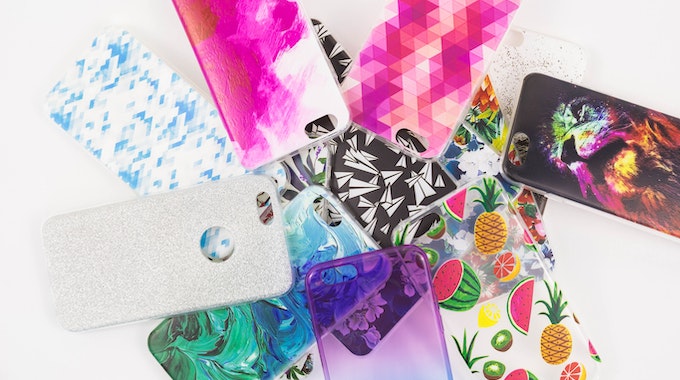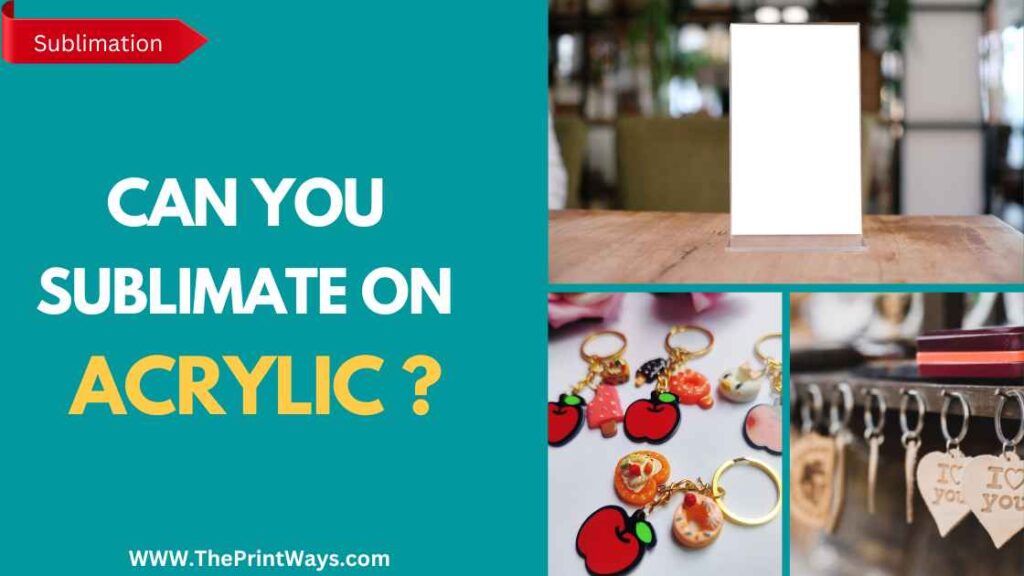Acrylic is a popular material in crafting and design due to its versatility and durability.
The use of acrylic surfaces, however, can make it difficult to add a unique touch. But Can You Sublimate on Acrylic?.
We’ll explore the process of sublimation on acrylic and demonstrate how it may elevate your acrylic works to new heights.
Everything from the tools and supplies you’ll need to sublimate something step by step will be discussed, along with advice on how to get the most outstanding results.
What is acrylic, and Can you sublimate on acrylic?
Acrylic is a type of plastic that is made from a polymer called polymethyl methacrylate (PMMA).
It’s sold under the trade name “plexiglass” as well.
Acrylic is a widely used material because of its adaptability and desirable properties, such as its transparency, resilience, and resistance to the elements.
It finds use in a variety of goods, including but not limited to windows, skylights, signage, and displays.
Acrylic has many advantages: lighter, more impact-resistant, and less likely to shatter than glass.
It’s also less challenging to work with in fabrication, shaping, and molding.
Sublimation onto acrylic is preferred because it is mainly made to receive the sublimation inks, although not all acrylics can be sublimated.
Ensure the acrylic you intend to use is sublimation-friendly by reading the product description carefully.
Also Read: Can you Sublimate on Rayon ?
Important Factors:
It would help if you considered these several factors before sublimation onto acrylic. So make sure any of these are completed accordingly to avoid any problems before sublimating on acrylic.
- Type of acrylic: When using a heat press, the temperature and pressure parameters can be customized to the acrylic and sublimation inks you’re working with. You must adhere to the manufacturer’s guidelines to get the best results from your heat press and acrylic.
- Surface quality: When it comes to the ultimate effect of the sublimation process, the quality of the acrylic’s surface might make a difference. To get the best results from sublimation, the character must be clean and devoid of scratches or other flaws.
- Color: Acrylic is translucent, so that the acrylic color will influence the final sublimation image color. Keep the acrylic color in mind when making the design file, or use the correct color to complete the look you want.
- Print quality: The resolution of the design file, the quality of the sublimation inks, and the printer’s calibration can all impact the final printed product. Use high-resolution design files and premium sublimation inks, and calibrate the printer for the best results.
- Cutting: A laser cutter or specialized cutting software can precisely carve out whatever shape you need from an acrylic sheet. When making the design file, it’s vital to consider the dimensions and shape of the acrylic.
- Protection: Even though acrylic is sturdy, it still needs to be safeguarded against scratches and other blemishes. An acrylic surface with a sublimation picture can be shielded from the sun using a clear coat or UV film.
Related: Can you Sublimate on Aluminum ?
How to Sublimate on Acrylic?

There are some required things you’ll need before sublimation onto acrylic.
Required Material to sublimate on acrylic:
- Sublimation printer
- Sublimation paper
- Sublimation inks
- Acrylic
- Heat press
- Protective tape
- Cleaning supplies
- Design file (A digital image file you want to transfer onto the acrylic.)
Step-By-Step Guide to Sublimate on Acrylic:
1- Prepare your design file:
Make or acquire a file of sufficiently high resolution for use to sublimate onto acrylic.
To print correctly, the file must be in RGB color mode and flipped horizontally.
The ability to convert images may already be a feature of your sublimation program. Always double-check the acrylic’s dimensions and shape before finalizing the design file.
2- Print your design on sublimation paper:
To get your design onto sublimation paper, simply use your sublimation printer.
Use the proper printer settings and sublimation inks for the best results.
If the ink isn’t fully saturated and the image isn’t printed in the correct orientation, you may need to alter the print parameters.
3- Apply protective tape:
To prevent scratches or other damage to the acrylic, wrap the surface with protective tape before beginning.
Blue painter’s or masking tape can seal off the acrylic’s edges, revealing its entire usable surface.
4- Clean the acrylic surface:
Remove any dirt or dust from the acrylic’s surface by cleaning it thoroughly.
The surface should be cleaned with a lint-free cloth and a gentle detergent or alcohol-based cleanser.
Any oils or other impurities that could prevent the ink from sticking must be eliminated.
5- Position the printed paper onto the acrylic:
Prepare the acrylic by placing the printed paper on it.
The printed side of the sublimation paper should be facing down on the acrylic.
Even out creases or bubbles by aligning the form with the acrylic and smoothing it down.
6- Preheat the heat press:
Heat press preheating: Set the heat press to the desired temperature, often between 365 and 385 degrees Fahrenheit, and let it run for about 5 minutes.
Check the Heat Press Temprature Chart for better understanding for different substrates and materials.
7- Place the acrylic in the heat press:
Prepare a heat press and insert the acrylic sheet: Put the top on the heat press and crank up the pressure as directed. Typically, 45 psi is the sweet spot for acrylics.
8- Press the acrylic:
Press the acrylic for the recommended time, usually around 90 seconds.
9- Remove the printed paper:
Carefully remove the printed paper from the acrylic, peeling it off gently.
10- Clean the acrylic surface:
In order to get rid of any remaining sublimation ink, it’s essential to clean the acrylic surface.
Any accumulated dust or dirt should be cleaned up using a microfiber or lint-free cloth.
You May Like: How to Sublimate on Wood? (8 Easy Steps)
(Optional) You can make the acrylic into any form you like, though this is not required. You can use a laser cutter or a cutting program to get the exact shape you need while working with acrylic.
(Optional ) Sublimated images on acrylic can be protected from scratches and wear using a UV protection film or clear finish.
However, if you couldn’t understand anything in the process then check out this tutorial :
Frequently Asked Questions
Q: What is sublimation printing, and Can you Sublimate onto acrylic?
Sublimation printing is a way to print that uses heat and pressure to move dye from one Material to another, such as acrylic.
In the sublimation process, a design is printed on special sublimation paper, then put on the acrylic surface.
The dye on the paper gets transferred to the acrylic by the heat and pressure of the heat press, making a bright and durable image.
Q: What are the benefits of sublimation onto acrylic?
There are several benefits of sublimation onto acrylic:
By Sublimating on acrylic, you can produce high-quality, bright graphics that are fade- and weather-resistant.
Acrylic is lightweight, robust, and simple to manufacture, form, and mold into many shapes.
Sublimation printing is a cost-effective method for producing personalized signs, displays, and promotional goods.
Q: What type of acrylic should I use to sublimate onto acrylic?
It is best to use sublimation acrylic, which is made in a way that allows it to work with sublimation inks.
Check the information about the acrylic you want to use to ensure it can be used to sublimate onto acrylic.
Q: How do I prepare the acrylic surface before I sublimate onto acrylic?
Remove any dust or debris from the acrylic surface before sublimating on acrylic.
Wipe the surface with a lint-free cloth dampened with rubbing alcohol or a mild detergent.
Any oils or other impurities that could prevent the ink from sticking must also be eliminated.
Q: What equipment do I need to sublimate on acrylic?
You need an acrylic sheet, a sublimation printer, a sublimation paper, sublimation inks, and a heat press to start sublimating on acrylic.
A design file, some cleaning materials, and some protective tape are other possible necessities.
Q: How long does it take to sublimate on acrylic?
The sublimation process can take different amounts of time depending on the type of acrylic and sublimation inks you use.
It’s essential to follow the manufacturer’s instructions for your heat press and acrylic and to test the process with a test piece of acrylic before doing the final part to ensure the time settings are correct.
Conclusion
In Conclusion, sublimation onto acrylic creates powerful and affordable personalized signage, displays, and promotional goods.
Acrylic is clear, resilient, and weatherproof.
Overall, the sublimation onto acrylic is likely to succeed, but it’s always important to follow the appropriate proced.ure. Sublimation onto acrylic can be beneficial with the proper method and materials.
I hope you found the answer for “Can you sublimate onto acrylic?”





